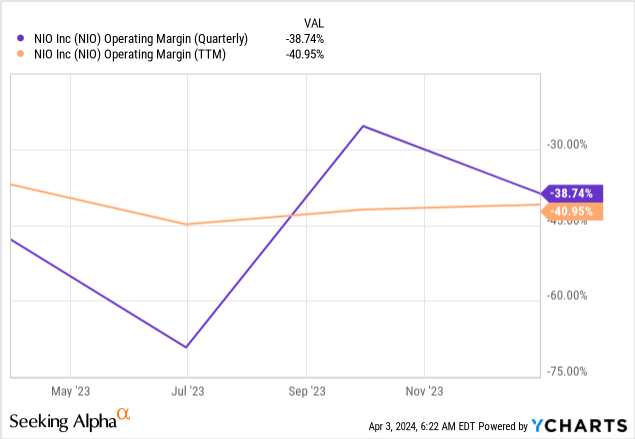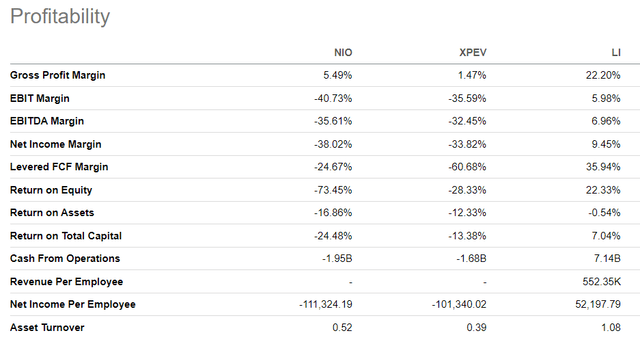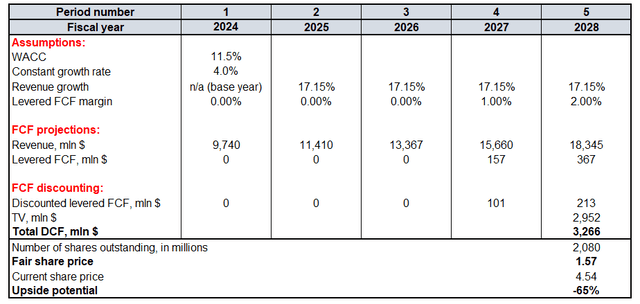Summary:
- NIO continues to lose market share to competitors as closest peers demonstrate the ability to ramp up faster.
- The emergence of Xiaomi’s electric vehicle poses a big threat to NIO’s ET7 model.
- My target price is $1.57.
ken tera/iStock Editorial via Getty Images
Introduction
Today, I want to update my thesis about NIO Inc. (NYSE:NIO). I covered the stock in January, for the first time and my rating for the stock was “Strong Sell” because I saw several weaknesses in the business. Since my first coverage went live, the stock has declined by 29%. I reiterate my bearish thesis because NIO continues to lose its market share as closest peers ramp up much faster, and the race intensifies with new solid players joining the battle. The company continues to be disappointing from the bottom line perspective, which looks inevitable given NIO’s thin, single-digit gross margin. Furthermore, the stock is still substantially overvalued, according to my valuation analysis.
Fundamental analysis
I want to start with the most fresh data, March and Q1 2024 deliveries. To provide readers with more value I am adding Q1 deliveries from NIO’s closest peers in the Chinese market. These include Li Auto Inc. (LI), XPeng Inc. (XPEV). NIO was the only company out of three to record a YoY decline in Q1, which means the company is losing its market share to competitors. LI and XPEV not only outpaced NIO, but their growth numbers are impressive without any context. Li’s success is especially impressive, delivering 80 thousand vehicles in Q1, a half of what NIO did for the full 2023.
And the competition is intensifying further. Chinese consumer electronics giant, Xiaomi (OTCPK:XIACF), launched sales of its first electric vehicle (“EV”). It looks to me that Xiaomi’s car is the direct competitor to NIO’s ET7. Xiaomi’s SU7 starts below $30,000 in China and it was sold out within the first 24 hours after official sales launched. To add context, NIO’s ET7 sedan starts above $70,000 in China. It appears like ET7 will be unable to compete with SU7 in pricing, and I doubt whether NIO will be able to justify the massive gap in prices to customers. Therefore, I see the emergence of Xiaomi’s car as a big threat to NIO.
I also want to highlight the latest earnings release. NIO delivered a consensus revenue beat on March 5, but disappointed in terms of the EPS. In my initial thesis, I emphasized warning trends in the company’s profitability and NIO again disappointed from the bottom line perspective. The gross profit is still very thin at 7.5% in Q4 2023 and the operating margin is still volatile and far from zero. On a TTM basis the operating margin improvement is slow, I believe.

NIO’s profitability looks not much worse than XPEV’s. On the other hand, Li Auto is already profitable across all key profitability metrics, which puts this company in a better position compared to NIO. While NIO struggles to achieve even shallow profitability improvements, Li Auto is already profitable and generates spare cash to reinvest into business and innovation. Therefore, I expect the gap between Li Auto and NIO regarding vehicle deliveries to widen further.
NIO’s balance sheet is robust with $7 billion in cash. However, the company continues to burn through hundreds of millions of USD in cash each quarter. As a result, I am uncertain about how long the company’s financial strength will last.
Losing the market share to close peers, intensifying competition, and ongoing cash burn appears to be a very weak fundamental combination. Therefore, I remain bearish about NIO’s future prospects.
Valuation analysis
I use the discounted cash flow (“DCF”) approach to update my NIO valuation analysis. I use an 11.5% WACC, as recommended by Finbox. I rely on the FY 2024 revenue consensus forecast of $9.74 billion and use a linear 17.15% CAGR for 2025-2028.
NIO is still not profitable and the level of uncertainty regarding the free cash flow margin is very high. However, Tesla (TSLA) first achieved sustainable positive FCF starting in FY 2019 when it had already surpassed $20 billion in revenue. Therefore, I assume that to generate at least 1% in FCF, the company must surpass $15 billion in revenue. Therefore, I expect NIO to start generating positive FCF no earlier than FY 2027, with a slow expansion. According to Seeking Alpha, there are 2.08 billion outstanding NIO shares at the moment. I project a 4% constant growth rate because NIO operates in an industry that enjoys solid positive secular transitions.
The fair share price of NIO is $1.57, according to my calculations above. This is substantially lower than the current share price, meaning there is still vast room to drop for NIO.
Mitigating factors
Since stock markets tend to grow over the long term, being bearish is inherently risky. NIO is losing competition, and its profitability dynamic is disappointing, but it does not mean that it is guaranteed that the unfavorable dynamic will last infinitely. The company might appoint new managers, which might come up with a promising turnaround plan to improve the situation. Or there is a possibility that a giant like BYD (OTCPK:BYDDY), which is not yet present in the premium segment, might decide to acquire NIO in order to expand into more high-end markets. Both these possible scenarios might lead to a solid share price boost and will likely work against my bearish thesis.
The stock is very volatile with a very wide 52-week range from $4.38 to $16.18. The stock is currently at all-time lows and a technical (not due to fundamental reasons) rebound might occur. I mean that the current all-time lows might prompt traders to buy the dip, leading to a short-term increase in price. Moreover, the short interest in NIO is substantial, which also might be a potential positive catalyst for the stock if short coverage occurs. Therefore, there is a probability that the stock might demonstrate a short-term spike before it goes down further closer to my fair value estimates.
Conclusion
I think that NIO is still a “Strong Sell” considering its soft performance compared to LI and XPEV and the intensifying competition with Xiaomi, which offers a competing model that is two times cheaper than NIO. Deeply unprofitable business means that NIO does not have many options to start pricing wars or seek new costly product developments. The valuation looks generous from my DCF perspective and my target price is significantly lower than the current share price.
Editor’s Note: This article discusses one or more securities that do not trade on a major U.S. exchange. Please be aware of the risks associated with these stocks.
Analyst’s Disclosure: I/we have no stock, option or similar derivative position in any of the companies mentioned, and no plans to initiate any such positions within the next 72 hours. I wrote this article myself, and it expresses my own opinions. I am not receiving compensation for it (other than from Seeking Alpha). I have no business relationship with any company whose stock is mentioned in this article.
Seeking Alpha’s Disclosure: Past performance is no guarantee of future results. No recommendation or advice is being given as to whether any investment is suitable for a particular investor. Any views or opinions expressed above may not reflect those of Seeking Alpha as a whole. Seeking Alpha is not a licensed securities dealer, broker or US investment adviser or investment bank. Our analysts are third party authors that include both professional investors and individual investors who may not be licensed or certified by any institute or regulatory body.




